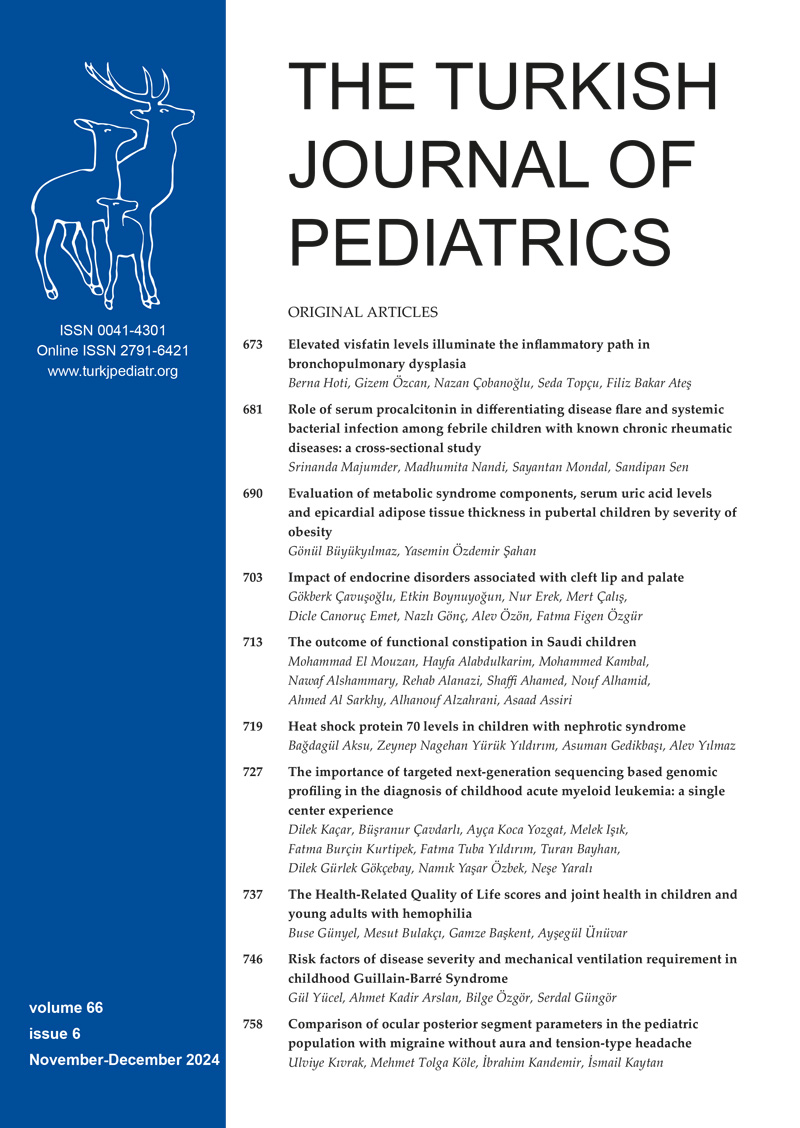Abstract
Background. Polyarteritis nodosa (PAN) is a rare and serious form of systemic necrotizing vasculitis that predominantly affects medium and small-sized arteries, with central nervous system involvement being particularly uncommon. Treatment strategies are tailored according to the extent and severity of the disease. While conventional therapy includes glucocorticoids and conventional disease-modifying-rheumatic drugs (cDMARDs), biologic agents may be critical for severe and refractory cases.
Case. We report a case of systemic PAN in a 7-year-old girl with no prior medical history, who presented with fever, abdominal pain, and altered mental status. Initial investigations with cranial MRI and echocardiography suggested encephalitis and myocarditis, respectively. Positive SARS-CoV-2 antibodies in both cerebrospinal fluid and serum oriented the diagnosis towards multisystem inflammatory syndrome in children. Despite intensive conventional therapies with glucocorticoids, cDMARDs, and intravenous immunoglobulins, the patient’s condition deteriorated. Elevated von Willebrand factor levels, hypertension, and proteinuria emerged, along with stable intracranial hemorrhage and abdominal organ infarctions on imaging, leading to the diagnosis of PAN. Cyclophosphamide was added to the treatment regimen. Three cranial aneurysms were identified on selective conventional cranial angiography. Following angiography, severe intraparenchymal bleeding was detected, leading to emergency cranial surgery. Unresponsiveness to conventional therapeutics led to treatment escalation with a tumor necrosis factor inhibitor, infliximab, resulting in clinical stabilization and allowing for successful endovascular coil embolization.
Conclusion. This case highlights the importance of considering a tumor necrosis factor inhibitor, infliximab, in severe PAN with involvement of intracranial aneurysm.
Keywords: polyarteritis nodosa, PAN, infliximab, intracranial aneurysm, COVID-19
References
- Ozen S, Besbas N, Saatci U, Bakkaloglu A. Diagnostic criteria for polyarteritis nodosa in childhood. J Pediatr 1992; 120: 206-209. https://doi.org/10.1016/s0022-3476(05)80428-7
- Jennette JC, Falk RJ, Bacon PA, et al. 2012 revised International Chapel Hill Consensus Conference Nomenclature of Vasculitides. Arthritis Rheum 2013; 65: 1-11. https://doi.org/10.1002/art.37715
- Ozen S, Pistorio A, Iusan SM, et al. EULAR/PRINTO/PRES criteria for Henoch-Schönlein purpura, childhood polyarteritis nodosa, childhood Wegener granulomatosis and childhood Takayasu arteritis: Ankara 2008. Part II: Final classification criteria. Ann Rheum Dis 2010; 69: 798-806. https://doi.org/10.1136/ard.2009.116657
- de Boysson H, Guillevin L. Polyarteritis nodosa neurologic manifestations. Neurol Clin 2019; 37: 345-357. https://doi.org/10.1016/j.ncl.2019.01.007
- Gupta N, Hiremath SB, Aviv RI, Wilson N. Childhood cerebral vasculitis: a multidisciplinary approach. Clin Neuroradiol 2023; 33: 5-20. https://doi.org/10.1007/s00062-022-01185-8
- Bova SM, Serafini L, Capetti P, et al. Neurological involvement in multisystem inflammatory syndrome in children: clinical, electroencephalographic and magnetic resonance imaging peculiarities and therapeutic implications. An Italian Single-Center Experience. Front Pediatr 2022; 10: 932208. https://doi.org/10.3389/fped.2022.932208
- Ginsberg S, Rosner I, Slobodin G, et al. Infliximab for the treatment of refractory polyarteritis nodosa. Clin Rheumatol 2019; 38: 2825-2833. https://doi.org/10.1007/s10067-019-04474-9
- Lerkvaleekul B, Treepongkaruna S, Ruangwattanapaisarn N, Treesit T, Vilaiyuk S. Recurrent ruptured abdominal aneurysms in polyarteritis nodosa successfully treated with infliximab. Biologics 2019; 13: 111-116. https://doi.org/10.2147/BTT.S204726
- Gupta V, Chinchure SD, Goe G, Jha AN, Malviya S, Gupta R. Coil embolization of intracranial aneurysm in polyarteritis nodosa. A case report and review of the literature. Interv Neuroradiol 2013; 19: 203-208. https://doi.org/10.1177/159101991301900209
- de Kort SW, van Rossum MA, ten Cate R. Infliximab in a child with therapy-resistant systemic vasculitis. Clin Rheumatol 2006; 25: 769-771. https://doi.org/10.1007/s10067-005-0071-7
- Toyoda K, Tsutsumi K, Hirao T, et al. Ruptured intracranial aneurysms in pediatric polyarteritis nodosa: case report. Neurol Med Chir (Tokyo) 2012; 52: 928-932. https://doi.org/10.2176/nmc.52.928
- Lee JS, Kim JG, Lee S. Clinical presentations and long term prognosis of childhood onset polyarteritis nodosa in single centre of Korea. Sci Rep 2021; 11: 8393. https://doi.org/10.1038/s41598-021-87718-6
- Oran I, Memis A, Parildar M, Yunten N. Multiple intracranial aneurysms in polyarteritis nodosa: MRI and angiography. Neuroradiology 1999; 41: 436-439. https://doi.org/10.1007/s002340050779
- Sharma S, Kumar S, Mishra NK, Gaikwad SB. Cerebral miliary micro aneurysms in polyarteritis nodosa: report of two cases. Neurol India 2010; 58: 457-459. https://doi.org/10.4103/0028-3886.65840
- Becker RC. COVID-19-associated vasculitis and vasculopathy. J Thromb Thrombolysis 2020; 50: 499-511. https://doi.org/10.1007/s11239-020-02230-4
- Batu ED, Sener S, Ozomay Baykal G, et al. The characteristics of patients with COVID-19-associated pediatric vasculitis: an international, multicenter study. Arthritis Rheumatol 2023; 75: 499-506. https://doi.org/10.1002/art.42411
- Makiyama A, Abe Y, Furusawa H, et al. Polyarteritis nodosa diagnosed in a young male after COVID-19 vaccine: a case report. Mod Rheumatol Case Rep 2023; 8: 125-132. https://doi.org/10.1093/mrcr/rxad037
- Zhou Q, Yang D, Ombrello AK, et al. Early-onset stroke and vasculopathy associated with mutations in ADA2. N Engl J Med 2014; 370: 911-920. https://doi.org/10.1056/NEJMoa1307361
- Kasap Cuceoglu M, Sener S, Batu ED, et al. Systematic review of childhood-onset polyarteritis nodosa and DADA2. Semin Arthritis Rheum 2021; 51: 559-564. https://doi.org/10.1016/j.semarthrit.2021.04.009
- Eleftheriou D, Melo M, Marks SD, et al. Biologic therapy in primary systemic vasculitis of the young. Rheumatology (Oxford) 2009; 48: 978-986. https://doi.org/10.1093/rheumatology/kep148
- Conticini E, Sota J, Falsetti P, et al. Biologic drugs in the treatment of polyarteritis nodosa and deficit of adenosine deaminase 2: a narrative review. Autoimmun Rev 2021; 20: 102784. https://doi.org/10.1016/j.autrev.2021.102784
Copyright and license
Copyright © 2024 The Author(s). This is an open access article distributed under the Creative Commons Attribution License (CC BY), which permits unrestricted use, distribution, and reproduction in any medium or format, provided the original work is properly cited.















